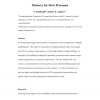Free Online Productivity Tools
i2Speak
i2Symbol
i2OCR
iTex2Img
iWeb2Print
iWeb2Shot
i2Type
iPdf2Split
iPdf2Merge
i2Bopomofo
i2Arabic
i2Style
i2Image
i2PDF
iLatex2Rtf
Sci2ools
KES
2010
Springer
2010
Springer
Evolving takagi sugeno modelling with memory for slow processes
Evolving Takagi Sugeno (eTS) models are optimised for use in applications with high sampling rates. This mode of use produces excellent prediction results very quickly and with low memory requirements, even with large numbers of input attributes. In this paper eTS modelling is adapted for optimality in situations where memory usage and processing time are not specific requirements. The new method, eTS with memory, is demonstrated on two financial time series, both the fullband signals and after decomposition by the discrete wavelet transform. It is shown that the use of previous inputs and multiple iterations in eTS can produce better predictions for signals which are not dominated by the characteristics of noise. Keywords Evolving Takagi Sugeno, Fuzzy, Modelling, Noise, Discrete Wavelet Transform
Discrete Wavelet | Financial Time Series | Information Technology | KES 2010 | Low Memory Requirements |
| Added | 29 Jan 2011 |
| Updated | 29 Jan 2011 |
| Type | Journal |
| Year | 2010 |
| Where | KES |
| Authors | Simon McDonald, Plamen P. Angelov |
Comments (0)

